This text (and the following) focuses on developments out there—a proof as to why markets pattern, explanation why it’s good to know that markets pattern, then lastly, a big analysis part into how a lot markets pattern. This evaluation will initially be proven on 109 market indices that contain home, worldwide, and commodity sectors. Following that the complete listing of all S&P GICS sectors, trade teams, and industries are proven following the identical format. There’s a large amount of information in these two sections. I attempt to slice via it with easy evaluation, retaining in thoughts that plenty of knowledge doesn’t equate to data.
Why Markets Pattern
Traits in markets are typically attributable to short-term supply-and-demand imbalances with a heavy overdose of human emotion. While you purchase a inventory, you realize that somebody needed to promote it to you. If the market has been rising lately, then you realize you’ll most likely pay a better worth for it, and the vendor additionally is aware of he can get a better worth for it. The shopping for enthusiasm is way better than the promoting enthusiasm.
I hate it when the monetary media makes a remark when the market is down by saying that there are extra sellers than consumers. They clearly don’t perceive how these markets work. Primarily based on shares, there are at all times the identical variety of consumers and sellers; it’s the shopping for and promoting enthusiasm that modifications.
Trending is a constructive suggestions course of. Even Isaac Newton believed in developments together with his first legislation of movement, which said that an object at relaxation stays at relaxation, whereas an object in movement stays in movement, with the identical velocity and in the identical course until acted on by an unbalanced drive. Hey, an apple will proceed to fall till it hits the bottom. Constructive suggestions is the direct results of an investor’s confidence within the worth pattern. When costs rise, buyers confidently purchase into increased and better costs.
Provide and Demand
A purchaser of a inventory, which is the demand, bids for a certain quantity of inventory at a sure worth. A vendor, which is the provide, presents a certain quantity at a sure worth. I feel it’s truthful to say that one buys a inventory with the anticipation that they’ll promote it later to somebody at a better worth. Not an unreasonable want, and doubtless what drives most buyers. The customer has no concept who will promote it to him, or why they might promote it to him. He could assume that he and the vendor have a whole disagreement on the long run worth of that inventory. And that is perhaps right; nevertheless, the client won’t ever know. The truth is, the client simply is perhaps the vendor’s one who buys it from him at a better worth.
The explanations for purchasing and promoting inventory are complicated and unattainable to quantify. Nevertheless, after they ultimately agree, what’s it that they agreed on? Was it the earnings of the corporate? Was it the merchandise the corporate produces? Was it the administration crew? Was it the quantity of the inventory’s dividend? Was it the gross sales revenues? Because it seems, it was none of these issues; the transaction was settled as a result of they agreed on the worth of the inventory, and that alone determines revenue or loss. Adjustments in provide and demand are mirrored instantly in worth, which is an instantaneous evaluation of provide and demand.
What Do You Learn about This Chart?
In Determine 10.1, I’ve eliminated the worth scale, the dates, and the identify of this difficulty; now let me ask you some questions on this difficulty.

- Is that this a chart of each day costs, weekly costs, or 30-minute costs?
- Is that this a chart of a inventory, a commodity, or a market index? (Okay, I am going to offer you this a lot, it’s a each day worth chart of a inventory over a interval of about six years.)
- Throughout this time period, there have been 11 earnings bulletins. Are you able to present me the place a type of bulletins occurred and, in the event you might, whether or not the earnings report was thought-about good or unhealthy?
- Additionally through the time period for this chart, there have been seven Federal Open Market Committee (FOMC) bulletins. Are you able to inform me the place considered one of them occurred, and whether or not the announcement was thought-about good or unhealthy?
- Does this inventory pay a dividend?
- Hurricane Katrina occurred throughout this era displayed on this chart; are you able to inform me the place it’s?
- Lastly, would you need to purchase this inventory initially of the interval displayed after which promote it on the finish of the interval (proper aspect of chart)?
I doubt, in actual fact, I know you can not reply many of the above questions with any device aside from guessing. The purpose of this train is to level out that there’s at all times and ever noise in inventory costs. This noise is available in a whole lot of various colours, sizes, shapes, and media codecs. The underside line is that it’s simply noise. The monetary media bombards us all day lengthy with noise. I don’t assume they do it maliciously; they do it as a result of they imagine they’re supplying you with priceless data that will help you make funding choices. Nothing could possibly be farther from the reality.
After all, query quantity 7 is the one query that the majority can reply, as a result of from the chart a buy-and-hold funding through the knowledge displayed clearly resulted in no funding development.
Nevertheless, let me let you know what I see as proven in Determine 10.2. I see two actually good uptrends and, if I had a trend-following methodology that would seize 65 % to 75 % of these uptrends, I might be completely happy. I additionally see two good downtrends, and if I had a strategy that would keep away from about 75 % of them, I might even be completely happy. When you might try this for the period of time proven on the chart beneath, then you definitely would come out significantly higher off than the buy-and-hold investor. I typically solely take part within the lengthy aspect of the market and transfer to money or money equivalents when defensive. Nevertheless, a long-short technique might probably derive even better revenue.
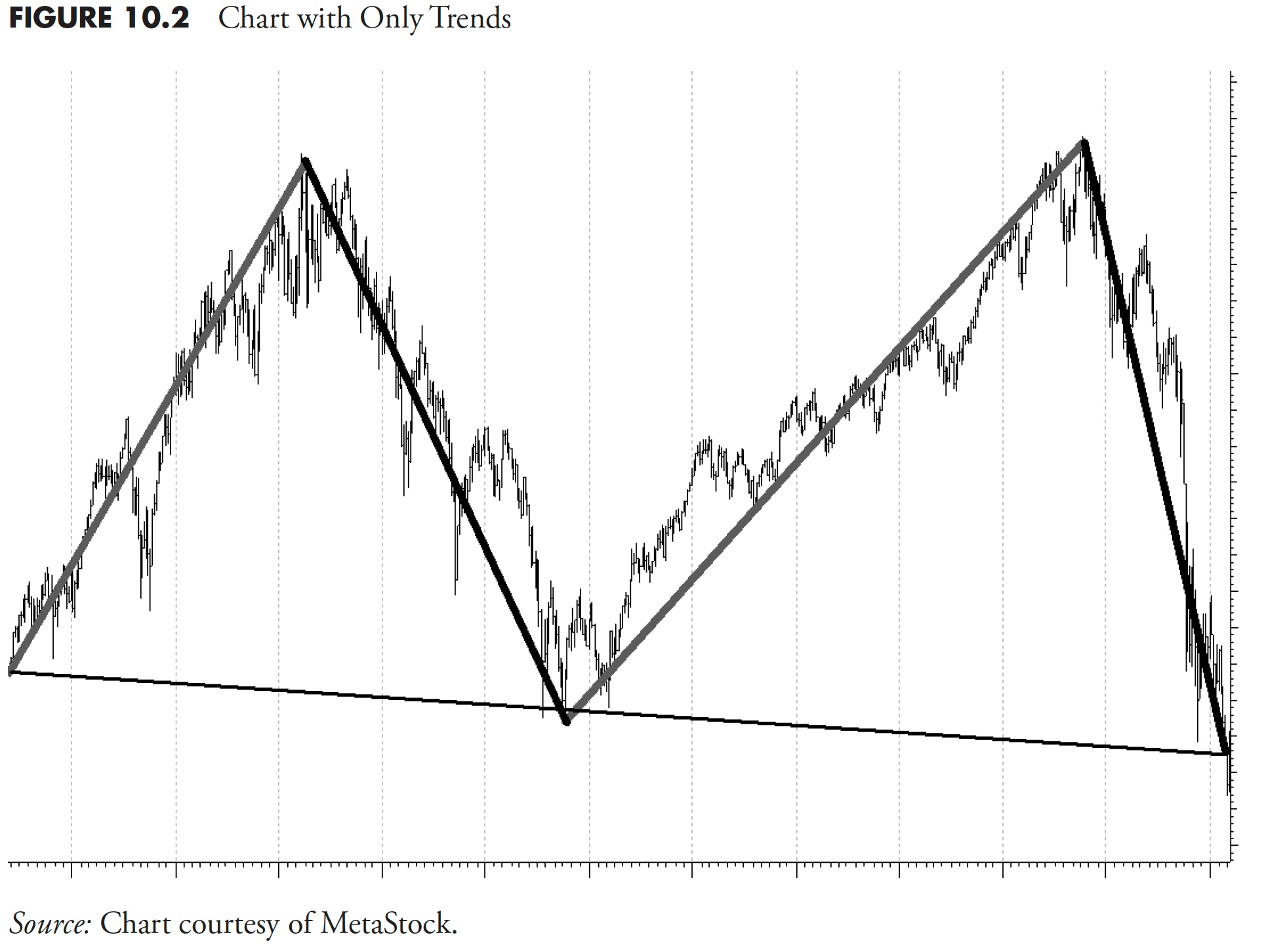
Pattern vs. Imply Reversion
I desire to make use of a market evaluation methodology known as pattern following. Generally it needs to be known as pattern continuation. Why? Pattern evaluation works on the completely researched idea that when a pattern is recognized, it has an inexpensive likelihood to proceed. I do know that’s the case as a result of, more often than not, markets are trending markets, and I see no purpose to undertake a distinct technique throughout a interval of imply reverting, akin to is skilled out there infrequently.
You’ll be able to consider pattern following as a constructive suggestions mechanism. Imply reverting measures are people who oscillate between predetermined parameters; oftentimes the number of these parameters is the issue. Imply reversion methods are clearly superior throughout these unstable sideways occasions, however the implementation of a imply reverting course of requires a degree of guessing that I refuse to be part of. You’ll be able to consider imply reversion as a detrimental suggestions mechanism.
In technical evaluation, there are various imply reverting measures that could possibly be used. They’re those the place you often hear the phrases overbought and oversold. Overbought means the measurement exhibits that costs have moved upward to a restrict that’s predefined. Oversold means the alternative—costs have moved all the way down to a predetermined degree. The issue with that kind of indicator or measurement is {that a} parameter must be set beforehand to know what the overbought and oversold ranges are. Additionally, in the event you imagine one thing imply reverts, you’ll most likely have issue in figuring out the speed of reversion. For imply reversion to be related, there should be a which means tied to common (imply) and, since most market knowledge doesn’t adhere to regular distributions, the imply is not as significant (sic). Form of like charting web value and eradicating billionaires to make the information much less skewed and subsequently a extra significant common.
Clearly, imply reverting measurements would work higher in extremely unstable markets, akin to we witness infrequently. One may ask the query: Why do not you incorporate each into your mannequin? A good query, however one which exhibits the inquiry is forgetting that hindsight will not be an evaluation device that may serve you effectively. When do you turn from one technique (pattern following) to the opposite (imply reversion)? Therein lies the issue.
One other query that is perhaps requested is why not use adaptive measures to assist determine the 2 kinds of markets. Once more, one other truthful query! I feel the lag between the 2 kinds of markets and the truth that usually there is no such thing as a clear interval of delineation is the difficulty. It’s a pure intuition to need to change the technique so as to reply extra rapidly from one to the opposite. Pure instincts are what we try to keep away from, just because they’re typically mistaken, and painfully mistaken on the worst occasions.
The transition from pattern following to imply reversion may be troublesome to see besides with 20/20 hindsight. For instance, once you view a chart which clearly has gone from trending to reversion, from that time, if we had used a easy imply reverting measurement, we might have regarded like geniuses. Nevertheless, in actuality, intervals like which have existed many occasions previously in total trending markets. Then the following downside turns into when to maneuver away from a imply reverting technique again to a pattern following one. Once more, hindsight at all times provides the exact reply, however in actuality this can be very troublesome to implement in actual time.
The underside line is that with markets that typically pattern more often than not, retaining a algorithm and cease loss ranges in place will most likely at all times win over the long-term. Sharpshooting the method is the start of the top. Pattern following is considerably much like a momentum technique besides for 2 important variations: one, momentum methods typically rank previous efficiency for choice, and two, usually they don’t make the most of stop-loss strategies, as an alternative transferring out and in of prime performers. They each depend on the persistence of worth conduct.
Pattern Evaluation
If one goes to be a pattern follower, what’s the very first thing that should be completed (rhetorical)? With a purpose to be a pattern follower, it’s essential to first decide the minimal size pattern you need to determine. You can’t comply with each little up and down transfer out there; it’s essential to resolve what the minimal pattern size is that you simply need to comply with. As soon as that is completed, you possibly can then develop trend-following indicators utilizing parameters that may assist determine developments out there primarily based on the minimal size you’ve gotten selected.
Determine 10.3 is an instance of assorted trend-following intervals. The highest plot is the Nasdaq Composite index. The second plot is a filtered wave exhibiting the pattern evaluation for a reasonably short-term-oriented pattern system. That is for merchants and people who need to attempt to seize each small up and down out there; a course of that isn’t adopted by this writer. The third plot is the perfect pattern system, the place it’s apparent that you simply purchase on the long-term backside and promote on the long-term prime. You will need to understand that this pattern evaluation can solely be completed with good 20/20 hindsight, and might be much more troublesome than the short-term course of proven within the second plot. The underside plot is a pattern evaluation course of that’s on the coronary heart of the ideas mentioned on this ebook. It’s a trend-following course of that realizes you can not take part in each small up and down transfer, however attempt to seize many of the up strikes and keep away from many of the down strikes.
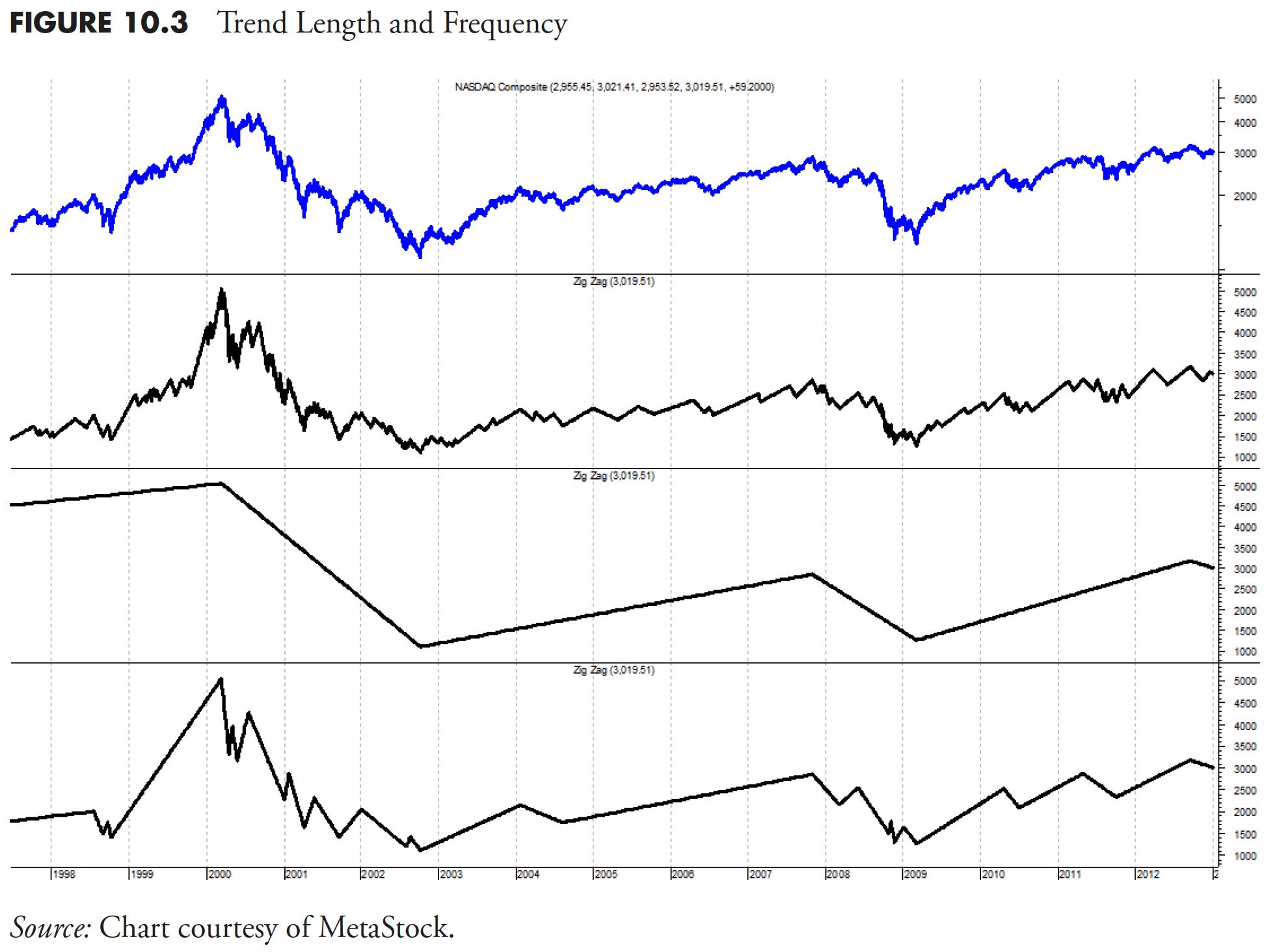
There’s a idea developed by the late Arthur Merrill known as Filtered Waves. A filtered wave is the measurement of worth actions through which solely the motion that exceeds a predetermined proportion is counted. The worth part used on this idea must be selected as as to if to make use of simply the closing costs for the filtered wave or use a mix of excessive and low costs. This is able to imply that, whereas costs are rising, the excessive could be used, and whereas costs are falling, the low worth could be used. I personally desire the excessive and low costs, as they honestly replicate the worth actions, whereas the closing costs solely would get rid of a few of the knowledge.
For instance, in Determine 10.4 , the background plot is the S&P 500 Index with each the shut C and the excessive low H-L filtered waves overlaid on the costs. You’ll be able to see that the H-L filtered wave methods picks up extra of the information; in actual fact, it exhibits a transfer of 5 % in the midst of the plot that the Shut solely model didn’t present. On this explicit instance, the zigzag line makes use of a filter of 5 %, which signifies that every time it modifications course, it had beforehand moved no less than 5 % in the other way. There’s one exception to this, and that’s the final transfer of the zigzag line (there’s a related dialogue in an earlier chapter). It merely strikes to the latest shut whatever the proportion moved so it should be ignored.
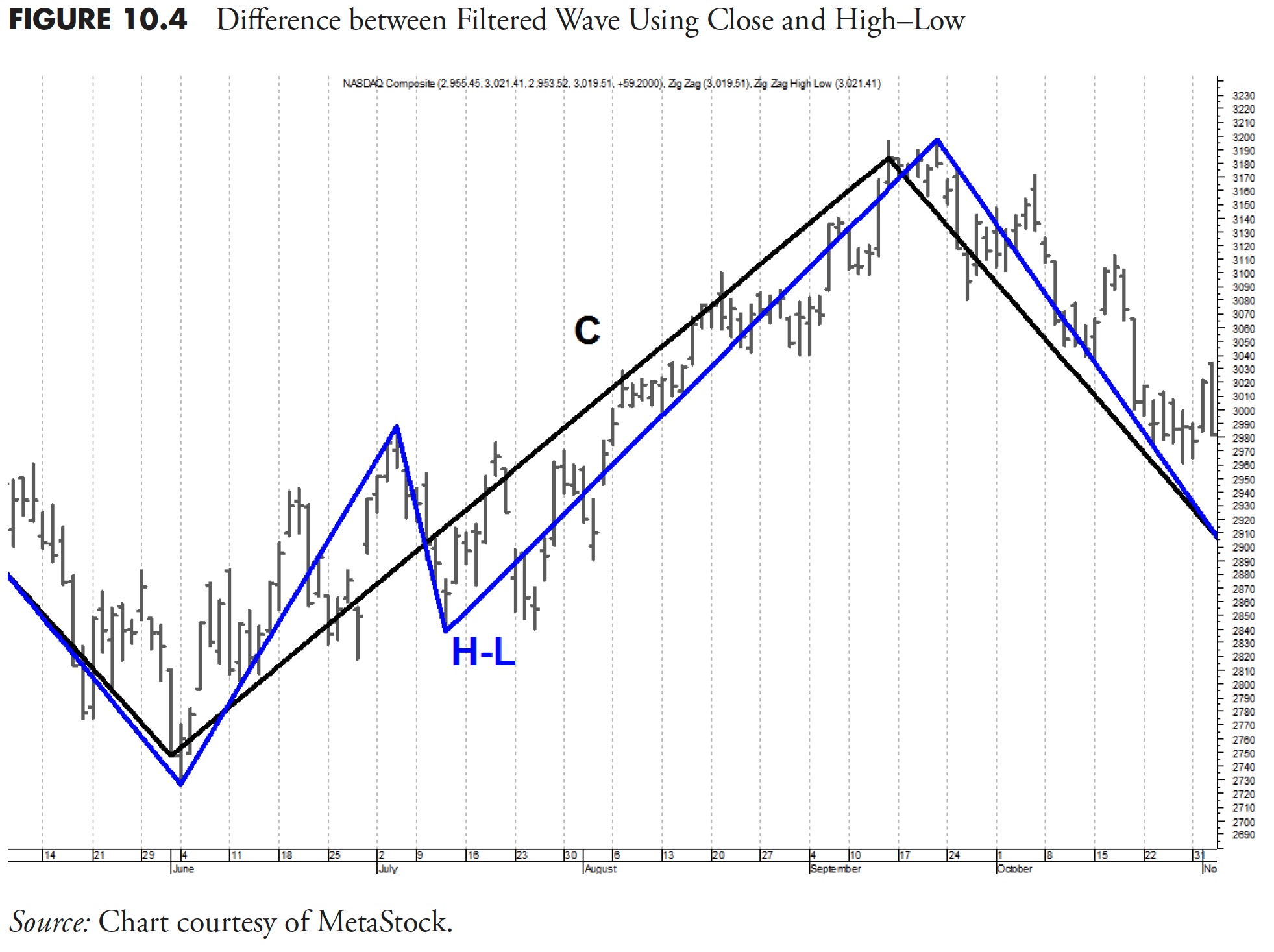
The underside plot in Determine 10.5 exhibits the filtered wave by breaking down the up strikes and down strikes after which counting the variety of intervals that have been in every transfer. There are three horizontal traces on that plot; the center one is at zero, which is the place the filtered wave modifications course. On this instance, the highest and backside traces are at +21 and -21 intervals, which imply that anytime the filtered wave exceeds these traces above or beneath, the pattern has lasted no less than 21 intervals. Discover that, on this instance, there was a interval initially (highlighted) the place the market moved up and down in 5% or better strikes with excessive frequency, however by no means lasted lengthy sufficient to exceed the 21 boundaries. Then, within the second half of the chart, there have been two good strikes that did exceed the 21 boundaries. This can be a good instance of a chart the place there was a trendless market (first half) and a trending market (second half). I used the high-low filtered wave of 5 % and 21 days for the minimal size as a result of that’s what I desire to make use of for many pattern evaluation.
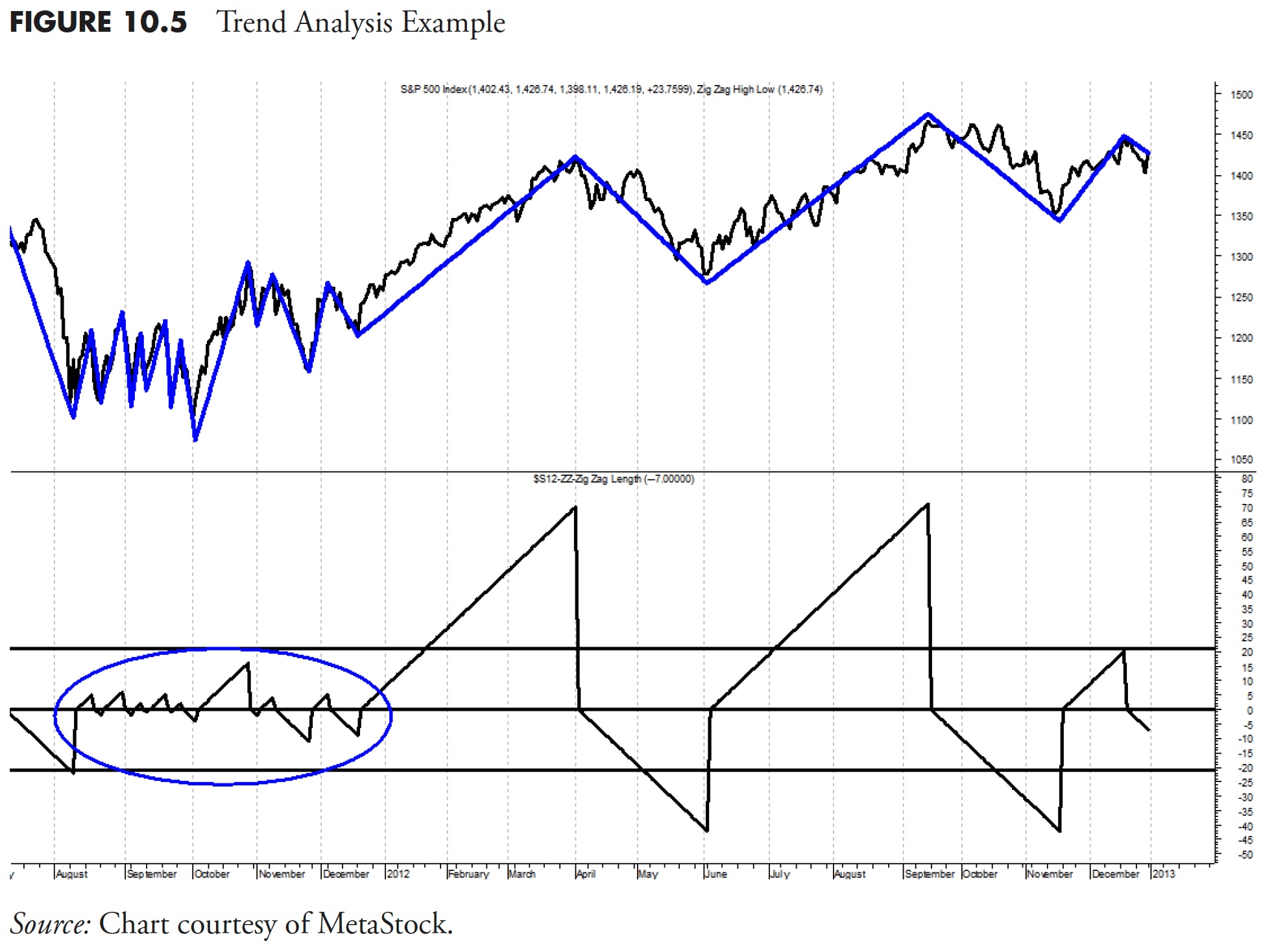
The next analysis was carried out utilizing the high-low filtered wave utilizing varied percentages and varied pattern size measures. The analysis was carried out on all kinds of market costs, akin to most home indices, most overseas indices, all the S&P sectors and trade teams; 109 points in all. I provide commentary all through so you possibly can see that this was a strong course of. Any indices or worth sequence that’s lacking was most likely due to an insufficient quantity of information, as you want a number of years of information to find out a sequence’ trendiness. The aim of this analysis was to find out that markets typically pattern and if there are some markets that pattern higher than others. Following this huge part, the pattern evaluation might be proven utilizing the S&P GICS knowledge on sectors, trade teams, and industries.
Desk 10.1 is the whole listing of indices used on this research together with the start date of the information.
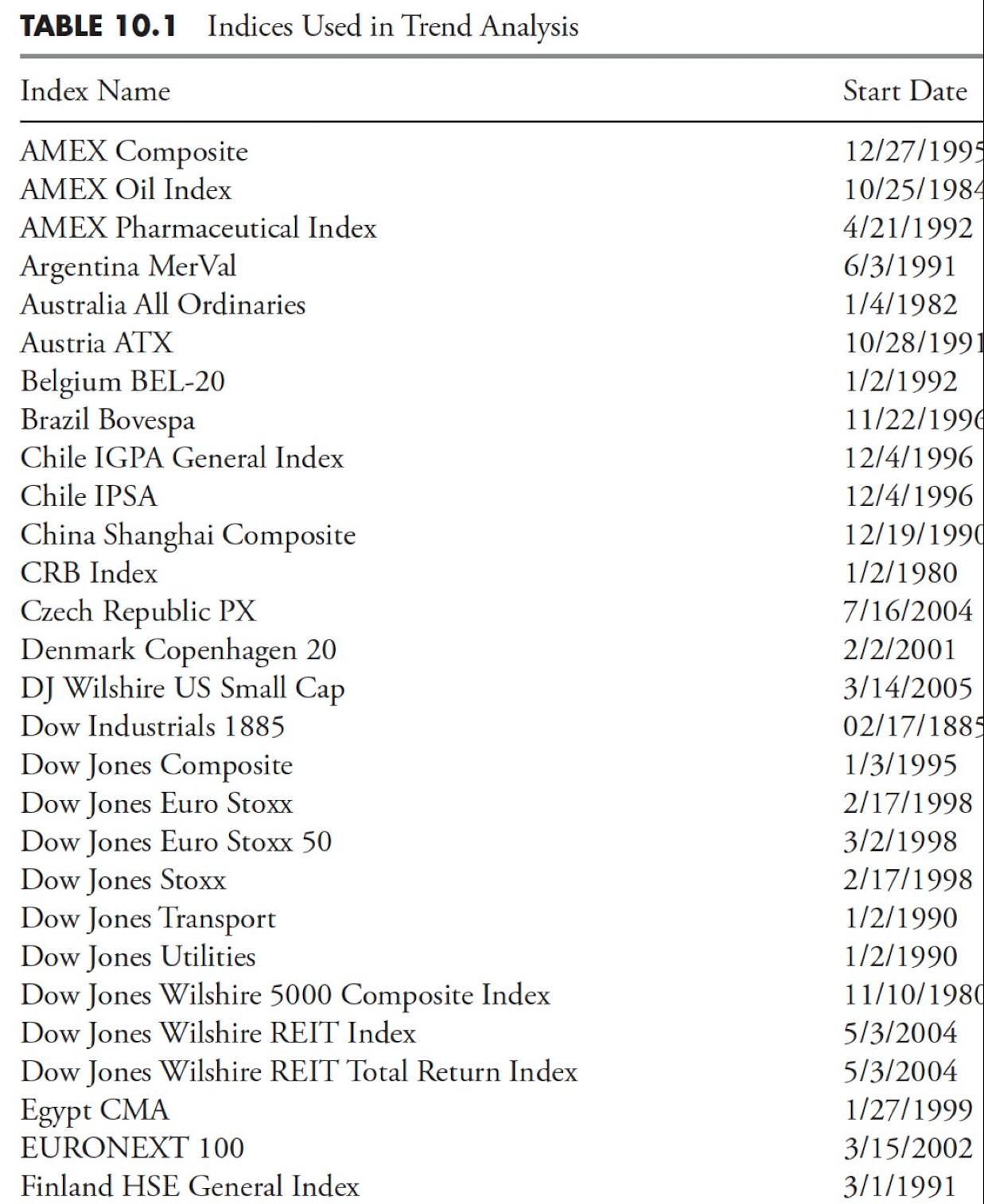
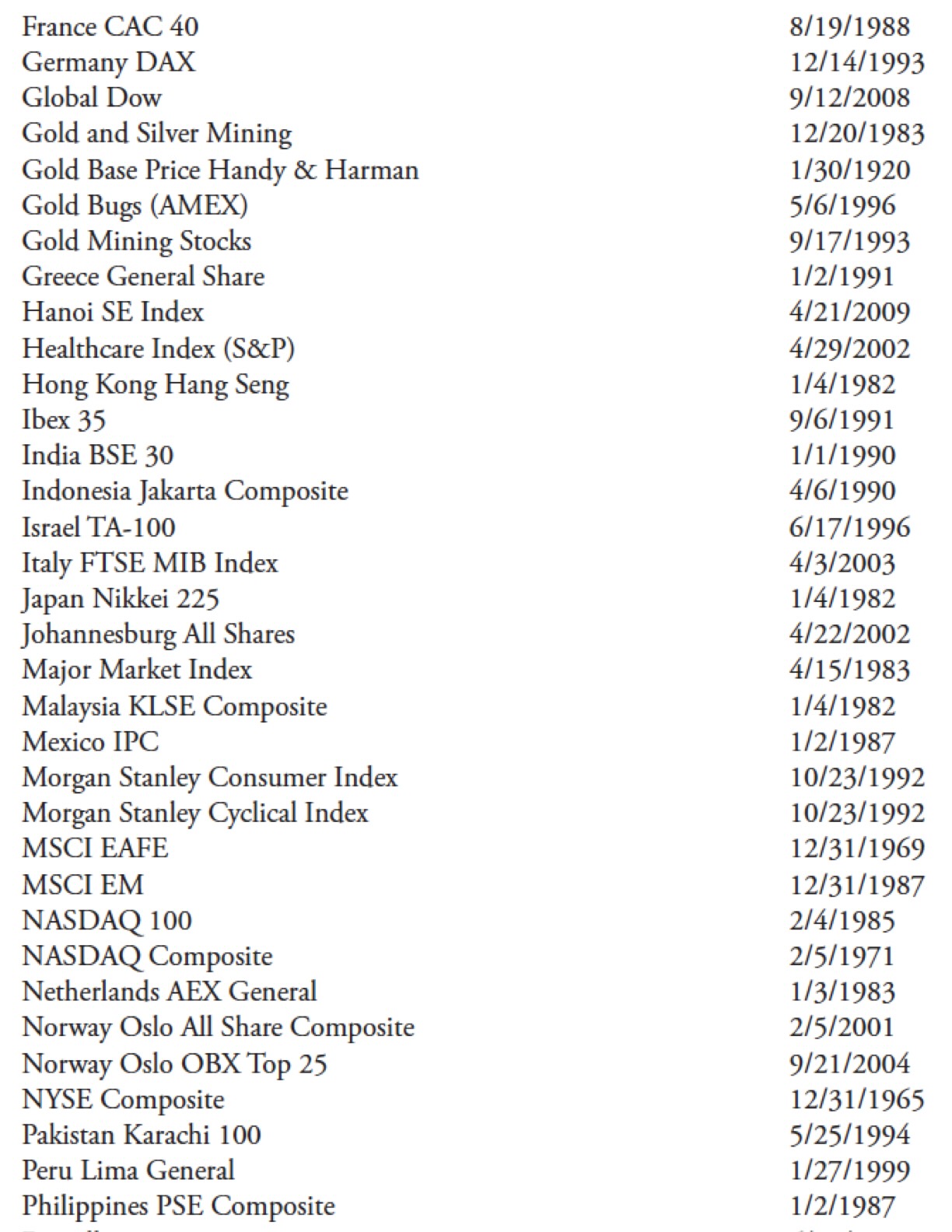


I did a number of units of information runs, however will clarify the method by exhibiting simply considered one of them. Desk 10.2 is the information run via all 109 indices for the 5% filtered wave and 21 days for the pattern to be recognized. The primary column is the identify of the index (they’re in alphabetical order), whereas the following 4 columns are the outcomes of the information runs for the entire pattern proportion, the uptrend proportion, the downtrend proportion, and the ratio of uptrends to downtrends.
The overall displays the period of time relative to the quantity of all knowledge accessible that the index was in a pattern mode outlined by the filtered wave and pattern time; within the case beneath, a pattern needed to final no less than 21 days and a transfer of 5% or better. The up measure is simply the share of the uptrend relative to the quantity of information. Equally, the downtrend is the share of the downtrend to the quantity of information. When you add the uptrend and downtrend, you’re going to get the entire pattern.
The final column is the U/D Ratio, which is merely the uptrend proportion divided by the downtrend proportion. When you have a look at the primary entry in Desk 10.2, the AMEX Composite developments 71.18 % of the time, with 56.16% of the time in an uptrend and 15.03% of the time in a downtrend. The U/D Ratio is 3.74, which implies the AMEX Composite developments up virtually 4 (3.74) occasions greater than it developments down. You’ll be able to confirm the quantity of information within the Indices Date desk proven early to see if it was enough sufficient for pattern evaluation. It’s not proven, however the complement of the entire would provide the period of time the index was trendless.
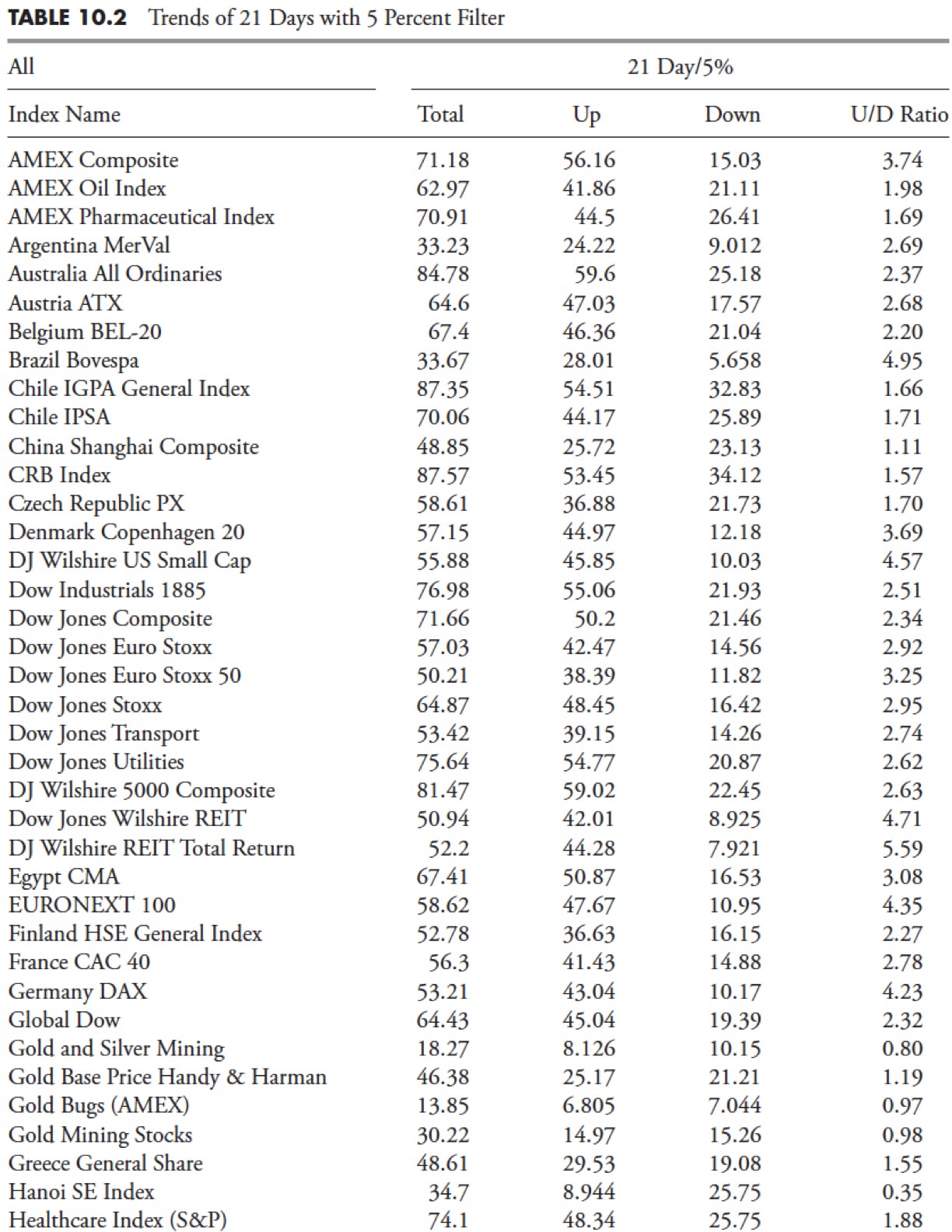
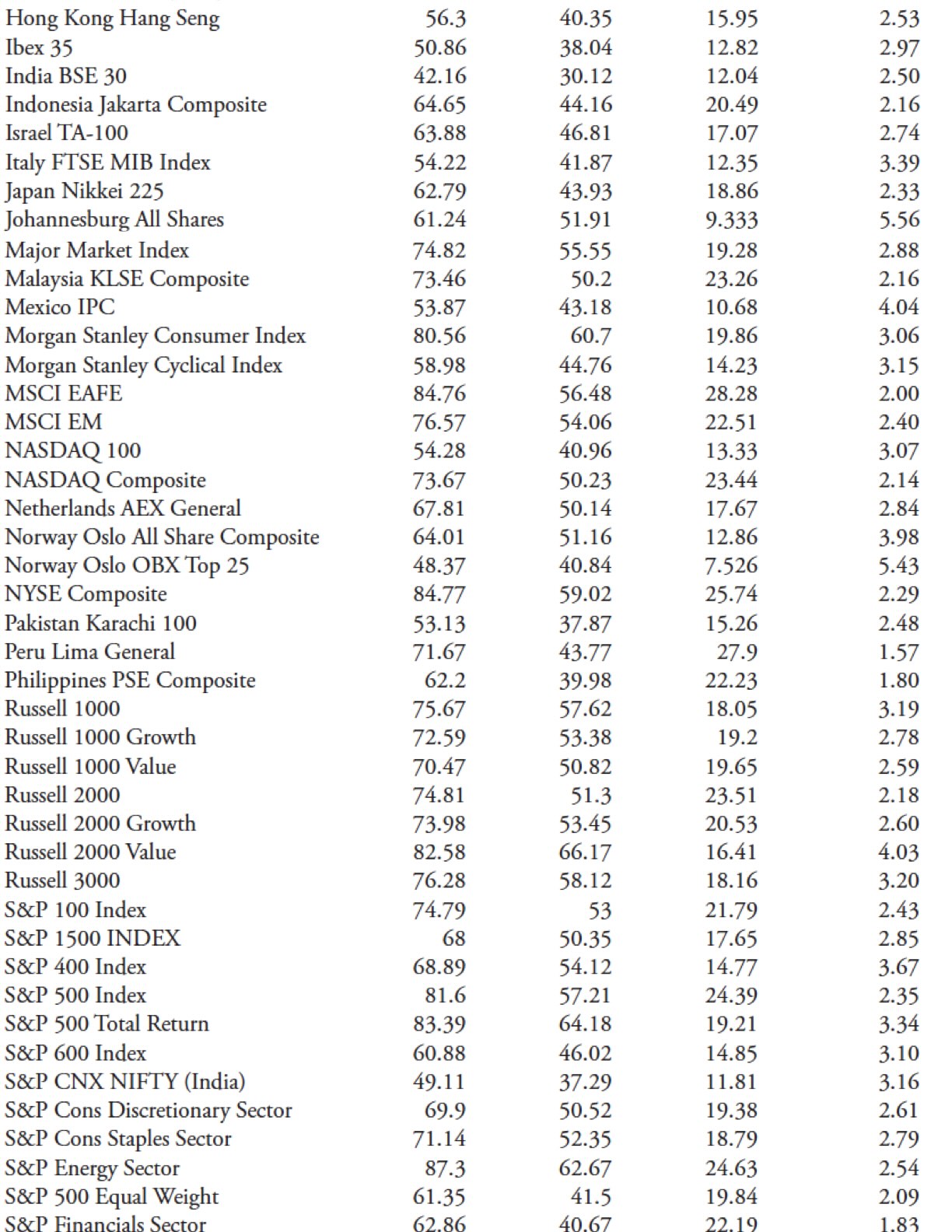
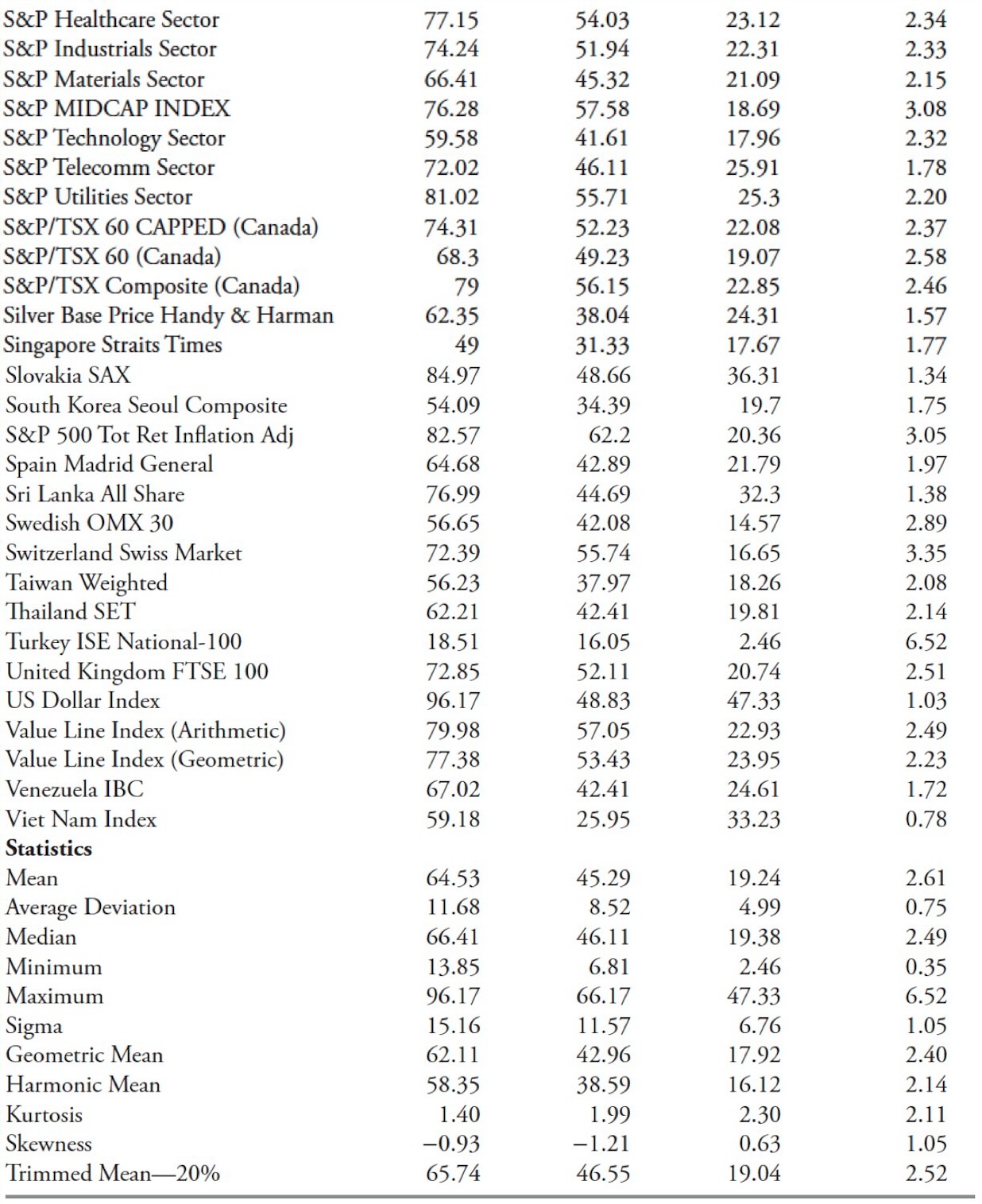
On the backside of every desk is a grouping of statistical measures for the assorted columns. Listed here are the definitions of these statistics:
Imply. In statistics, that is the arithmetic common of the chosen cells. In Excel, that is the Common operate (go determine). It’s a good measure so long as there are not any massive outliers within the knowledge being analyzed.
Common deviation. This can be a operate that returns the typical of absolutely the deviations of information factors from their imply. It may be regarded as a measure of the variability of the information.
Median. This operate measures central tendency, which is the situation of the middle of a bunch of numbers in a statistical distribution. It’s the center variety of a bunch of numbers; that’s, half the numbers have values which can be better than the median, and half the numbers have values which can be lower than the median. For instance, the median of two, 3, 3, 5, 7, and 10 is 4. If there are a variety of values which can be outliers, then median is a greater measure than imply or common.
Minimal. Exhibits the worth of the minimal worth of the cells which can be chosen.
Most. Exhibits the worth of the utmost worth of the cells which can be chosen.
Sigma. Often known as commonplace deviation. It’s a measure of how broadly values are dispersed from their imply (common).
Geometric imply. Initially, it’s only good for constructive numbers and can be utilized to measure development charges, and so on. It can at all times be a smaller quantity than the imply.
Harmonic imply. Merely the reciprocal of the arithmetic imply, or could possibly be said because the arithmetic imply of the reciprocals. It’s a worth that’s at all times lower than the geometric imply, and just like the geometric imply, can solely be calculated on constructive numbers and usually used for charges and ratios.
Kurtosis. This operate characterizes the relative peakedness or flatness of a distribution in contrast with the conventional distribution (bell curve). If the distribution is “tall”, then it displays constructive kurtosis, whereas a comparatively flat or quick distribution (relative to regular) displays a detrimental kurtosis.
Skewness. This characterizes the diploma of symmetry of a distribution about its imply. Constructive skewness displays a distribution that has lengthy tails of constructive values, whereas detrimental skewness displays a distribution with an uneven tail extending towards extra detrimental values.
Trimmed imply (20 %). This can be a nice operate. It’s the similar because the Imply, however you possibly can choose any quantity or proportion of numbers (pattern measurement) to be eradicated on the extremes. An effective way to get rid of the outliers in a knowledge set.
Trendiness Willpower Methodology One
This system for pattern dedication appears on the common of a number of units of uncooked knowledge. An instance of only one set of the information was proven beforehand in Desk 10.2, which appears at a filtered wave of 5% and a minimal pattern size of 21 days. Following Desk 10.3 is a proof of the column headers for Trendiness One within the evaluation tables that comply with.

Trendiness common. That is the easy common of all the entire trending expressed as a proportion. The parts that make up this common are the entire trendiness of all of the uncooked knowledge tables, through which the entire common is the typical of the uptrends and downtrends as a proportion of the entire knowledge within the sequence.
Rank. That is only a numerical rating of the trendiness common, with the biggest whole common equal to a rank of 1.
Avg. U/D. That is the typical of all of the uncooked knowledge tables’ ratio of uptrends to downtrends. Notice: If the worth of the Avg. U/D is the same as 1, it signifies that the uptrends and downtrends have been equal. Whether it is lower than 1, then there have been extra downtrends.
Uptrendiness WtdAvg. That is the product of column Trendiness Common and column Avg. U/D. Right here the Complete Trendiness (sum of up and down) is multiplied by their ratio, which supplies a weighted portion to the upside when the ratio is excessive. If the typical of the entire trendiness is excessive and the uptrendiness is significantly bigger than the downtrendiness, then this worth (WtdAvg) might be excessive.
Rank. This can be a numerical rating of the Up Trendiness WtdAvg, with the biggest worth equal to a rank of 1.
Desk 10.4 exhibits the whole outcomes utilizing Trendiness One methodology.
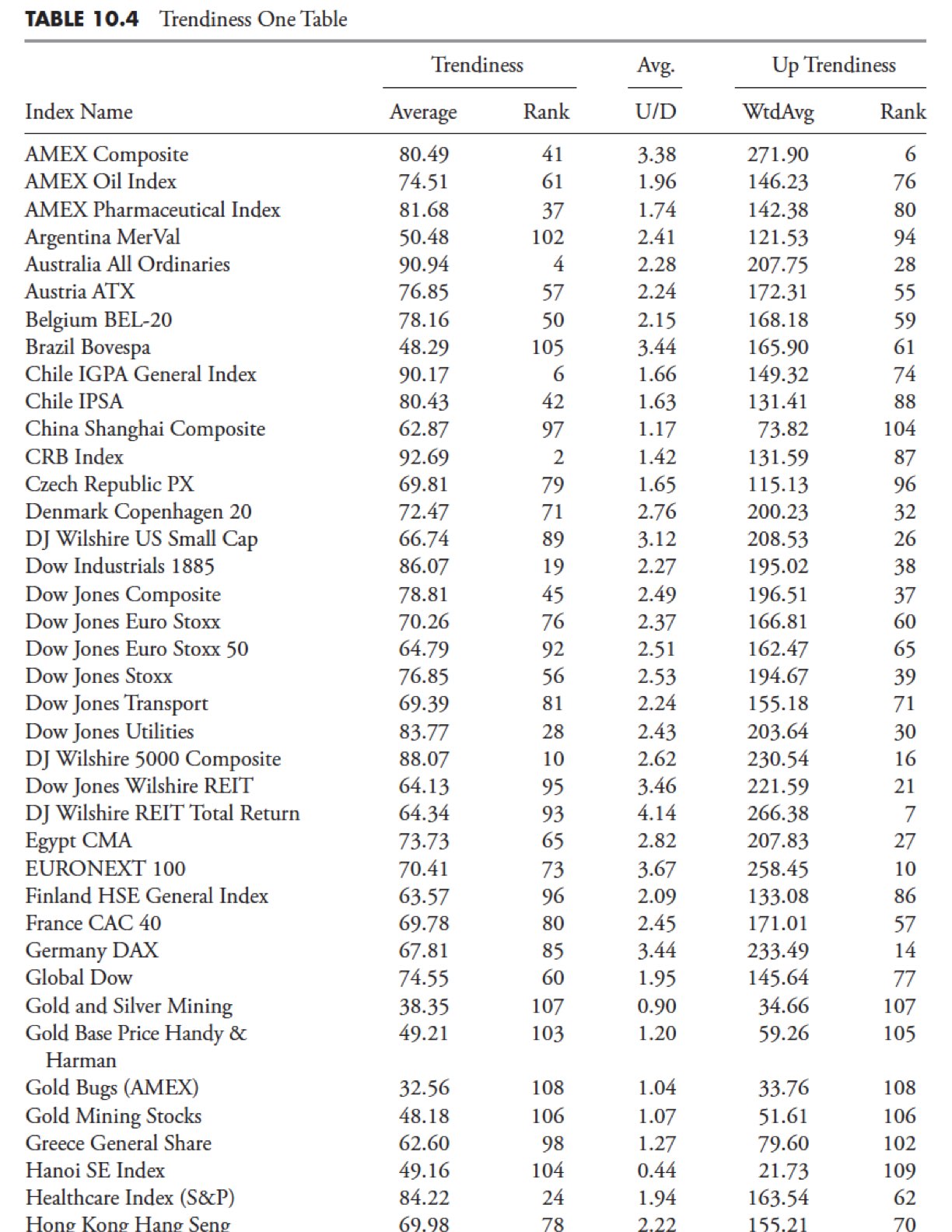
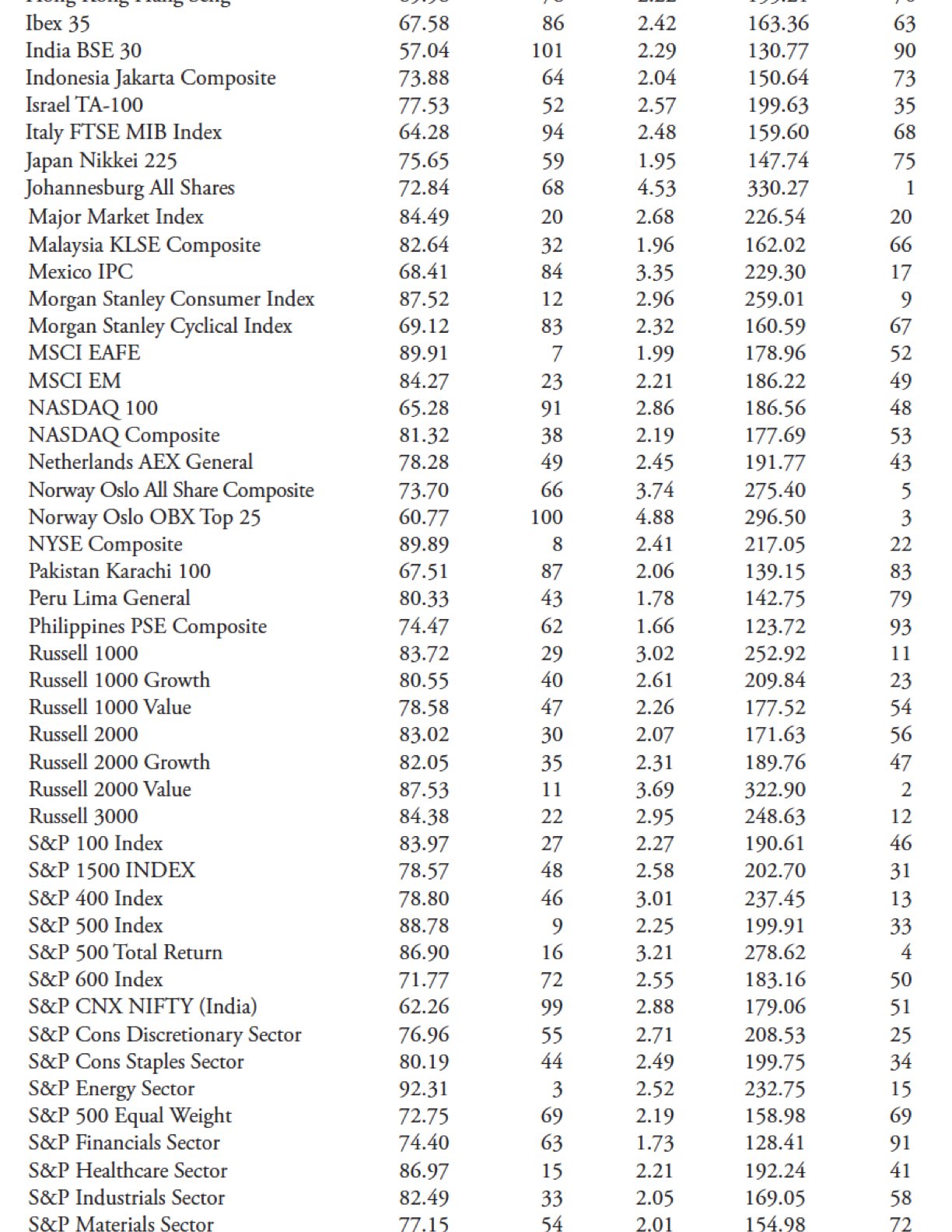
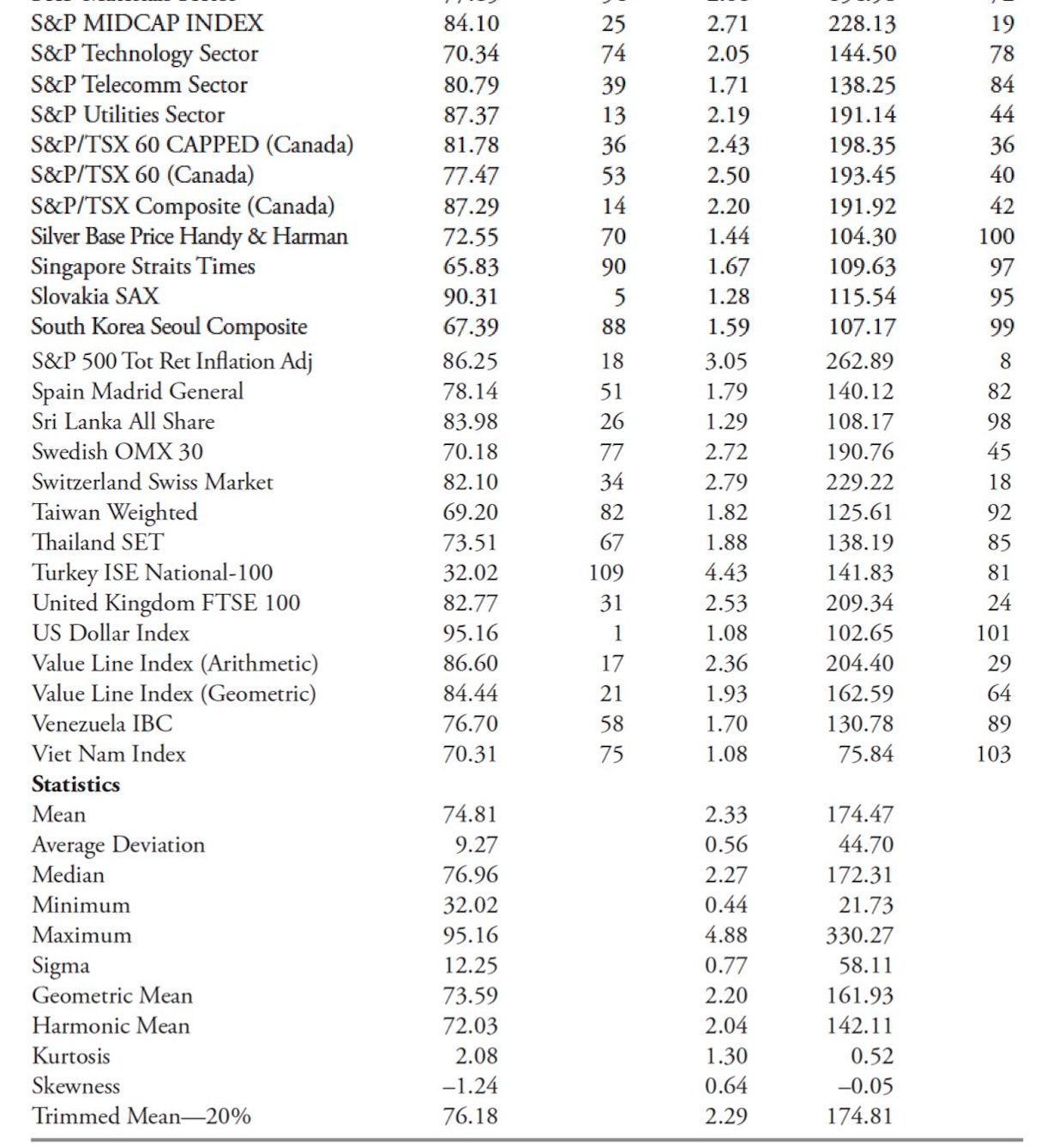
Trendiness Willpower Methodology Two
The second methodology of pattern dedication makes use of the uncooked knowledge averages. For instance, the up worth is calculated through the use of the uncooked knowledge up common in comparison with the uncooked knowledge whole common, which subsequently means it solely is utilizing the quantity of information that’s trending and never the complete knowledge set of the sequence. This manner, the outcomes are dealing solely with the trending portion of the index, and if you consider it, when the minimal pattern size is excessive and the filtered wave is low, there won’t be that a lot trending. Desk 10.5 exhibits the column headers adopted by their definitions.

Up. That is the typical of the uncooked knowledge Up Traits as a proportion of the Complete Traits.
Down. That is the typical of the uncooked knowledge Down Traits as a proportion of the Complete Traits.
Up rank. That is the numerical rating of the Up column, with the biggest worth equal to a rank of 1.
Desk 10.6 exhibits the outcomes utilizing Trendiness Two methodology.
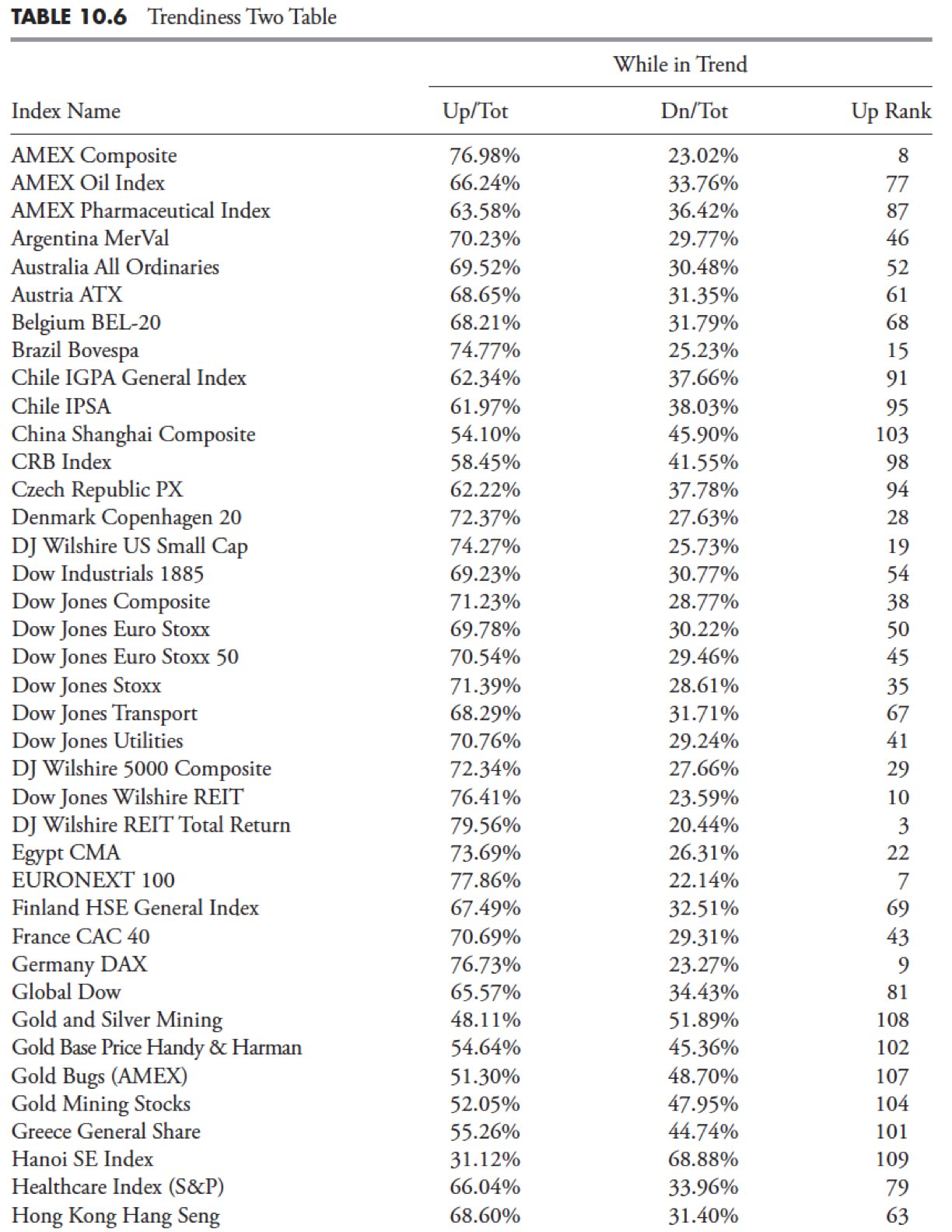
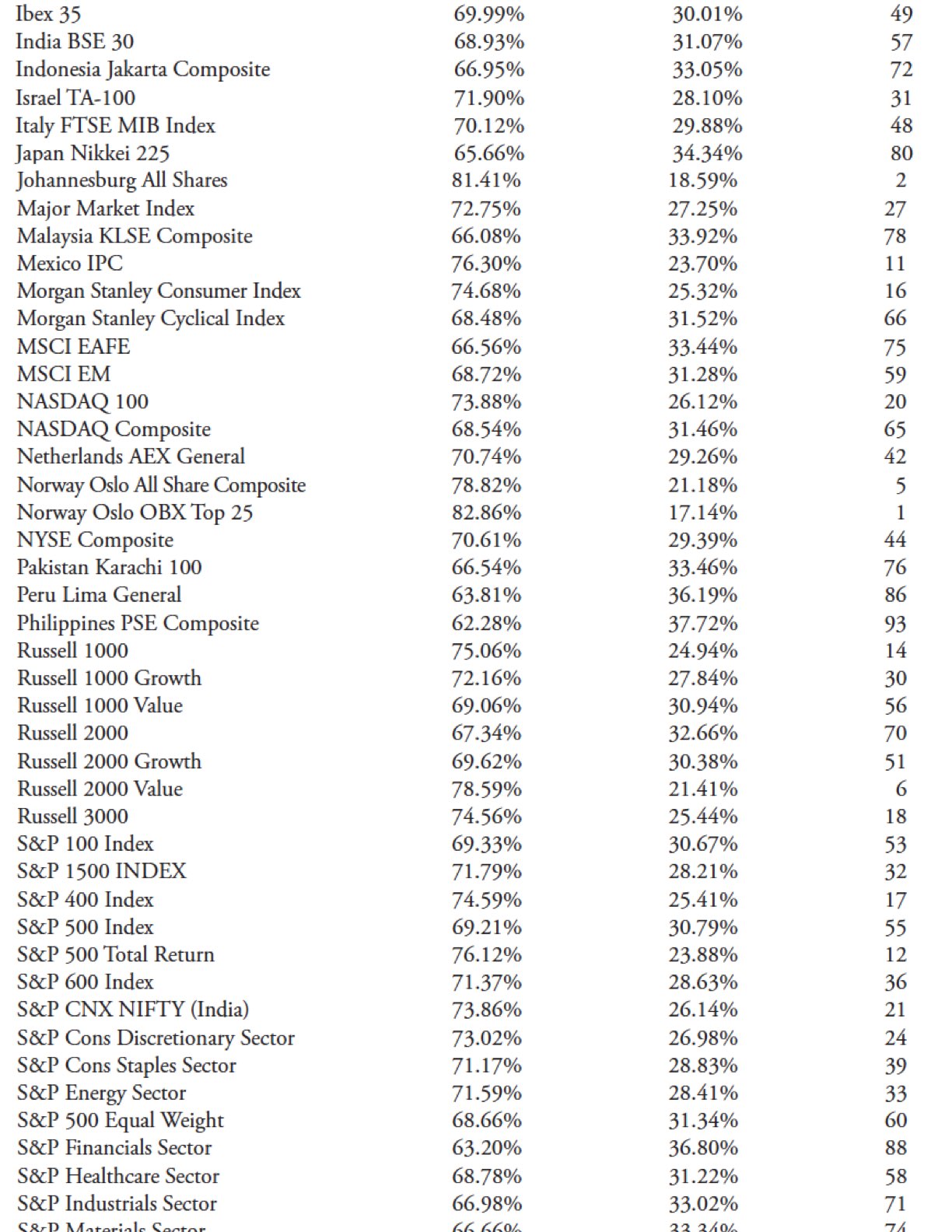
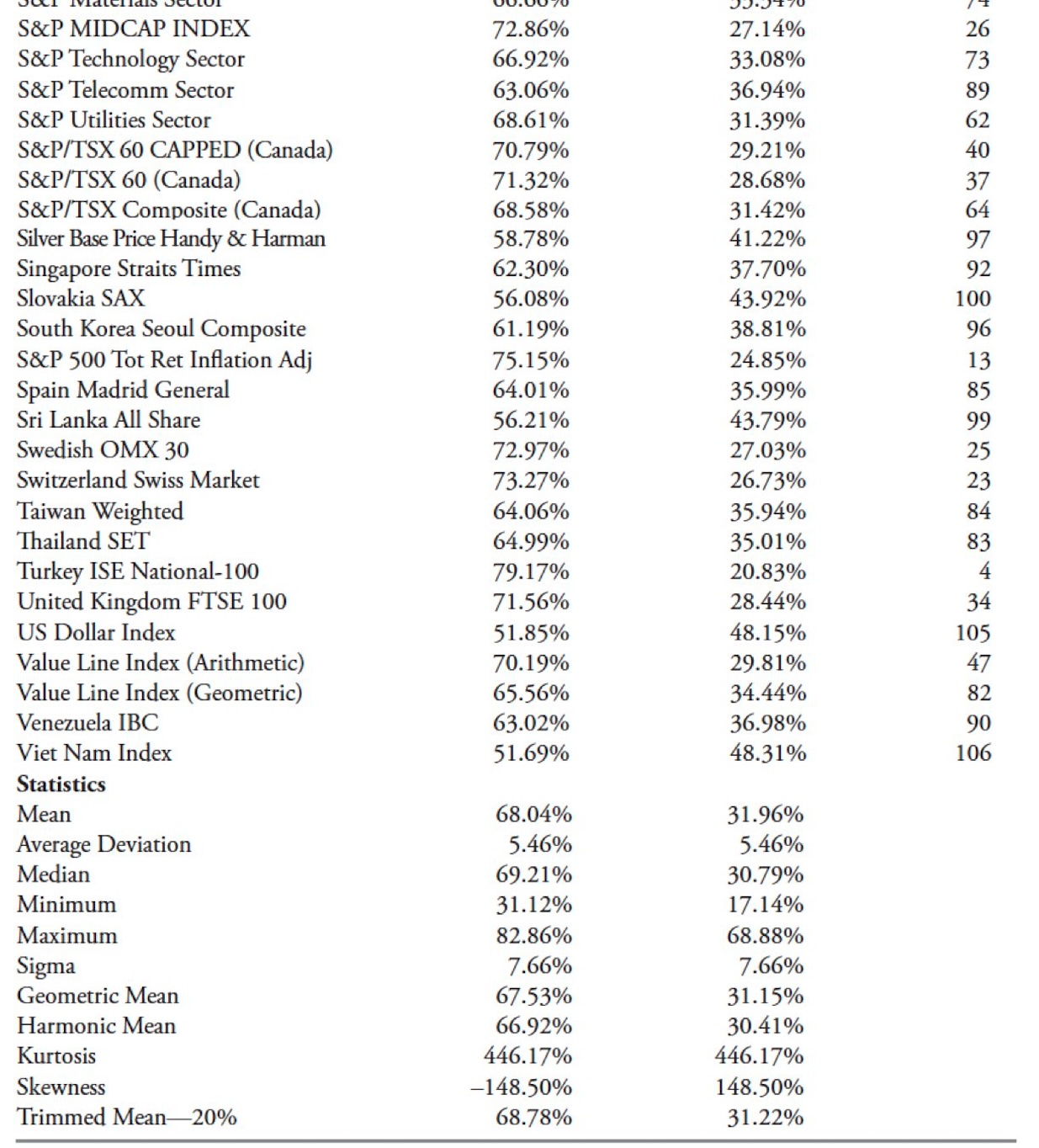
Comparability of the Two Trendiness Strategies
Determine 10.6 compares the rankings utilizing each “Trendiness” strategies. Bear in mind we’re solely utilizing uptrends, downtrends, and a spinoff of them, which is up over down ratio. The plot beneath is informally known as a scatter plot and offers with the relationships between two units of paired knowledge.
The equation of the regression line is from highschool geometry and follows the expression: y = mx + b, the place m is the slope and b is the y-intercept (the place it crosses the y axis); x is called the impartial variable or the predictor variable and y is the dependent variable or response variable. The expression that defines the regression (linear least squares) exhibits that the slope of the road (m) is 0.8904. The road crosses the y (vertical) axis at 6.027, which is b. R^2, which is often known as the coefficient of dedication, is 0.7928. From R^2, we will simply see that the correlation R is 0.8904 (sq. root of R^2). We all know it is a extremely constructive correlation as a result of we will visually confirm it merely from the orientation of the slope. We are able to interpret m as the worth of y when x is zero and we will interpret b as the quantity that y will increase when x will increase by one. From all of this, one can decide the quantity that one variable influences the opposite.
Sorry, I beat this to loss of life; you possibly can most likely discover easier explanations in a highschool statistics textbook.
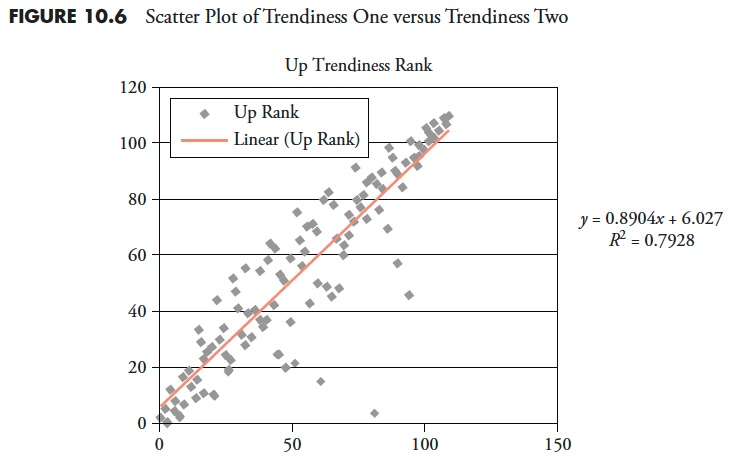
Trendless Evaluation
This can be a somewhat easy however complementary (intentional spelling) methodology that helps to validate the opposite two processes. This methodology focuses on the dearth of a pattern, or the quantity of trendless time that’s within the knowledge. The primary two strategies centered on trending, and this one is concentrated on nontrending, all utilizing the identical uncooked knowledge. Figuring out markets that don’t pattern will serve two functions. One is to not use standard trend-following methods on them, and the opposite is that it may be good for imply reversion evaluation. Desk 10.7 exhibits the column headers; the definitions comply with.

Up. That is the Complete Pattern common from Trendiness One multiplied by the Up Complete from Trendiness Two.
Down. That is the Complete Pattern common from Trendiness One multiplied by the Down Complete from Trendiness Two.
Trendless. That is the complement of the sum of the Up and Down values (1 – (Up + Down)).
Rank. That is the numerical rank of the Trendless column with the biggest worth equal to a rank of 1.
Desk 10.8 exhibits the outcomes utilizing the Trendless methodology.
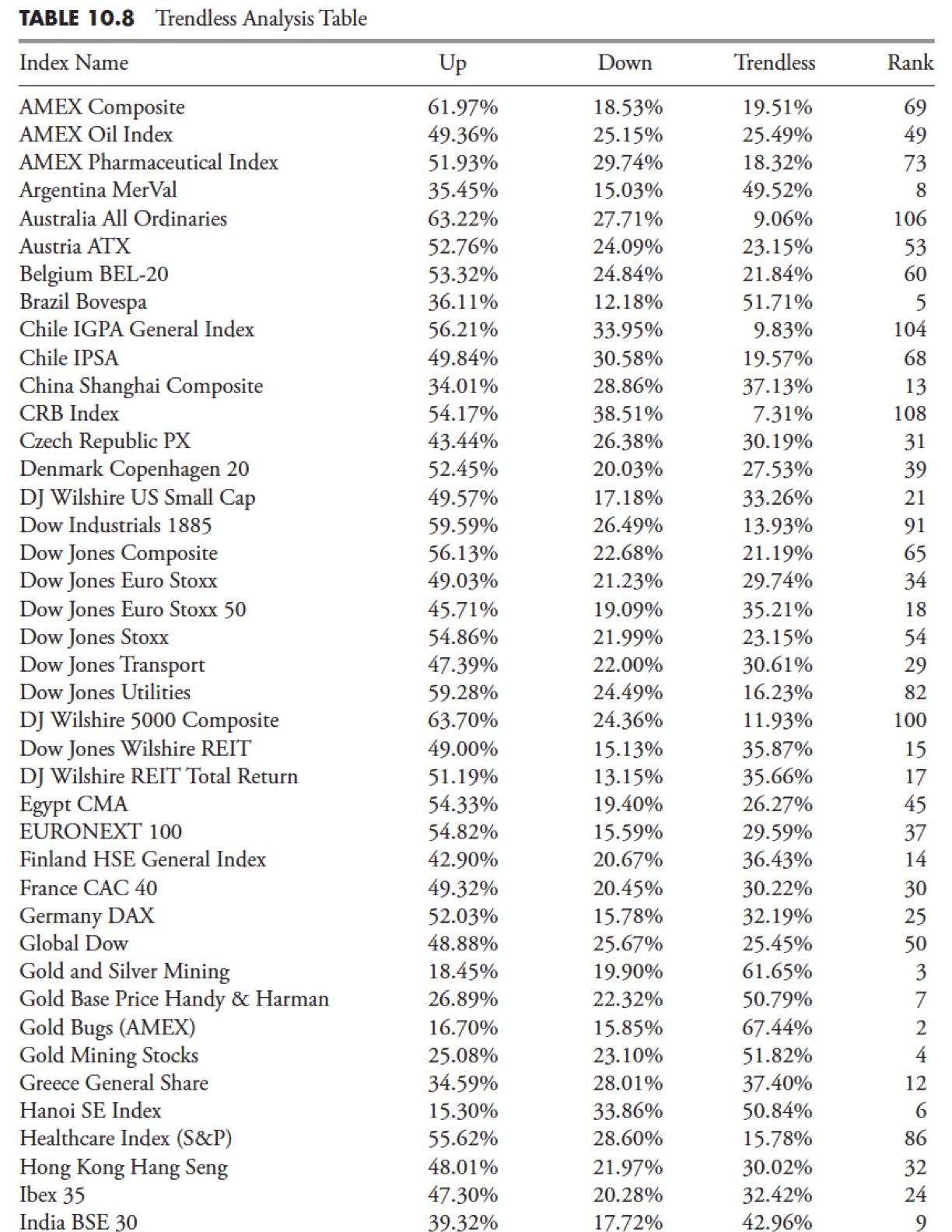
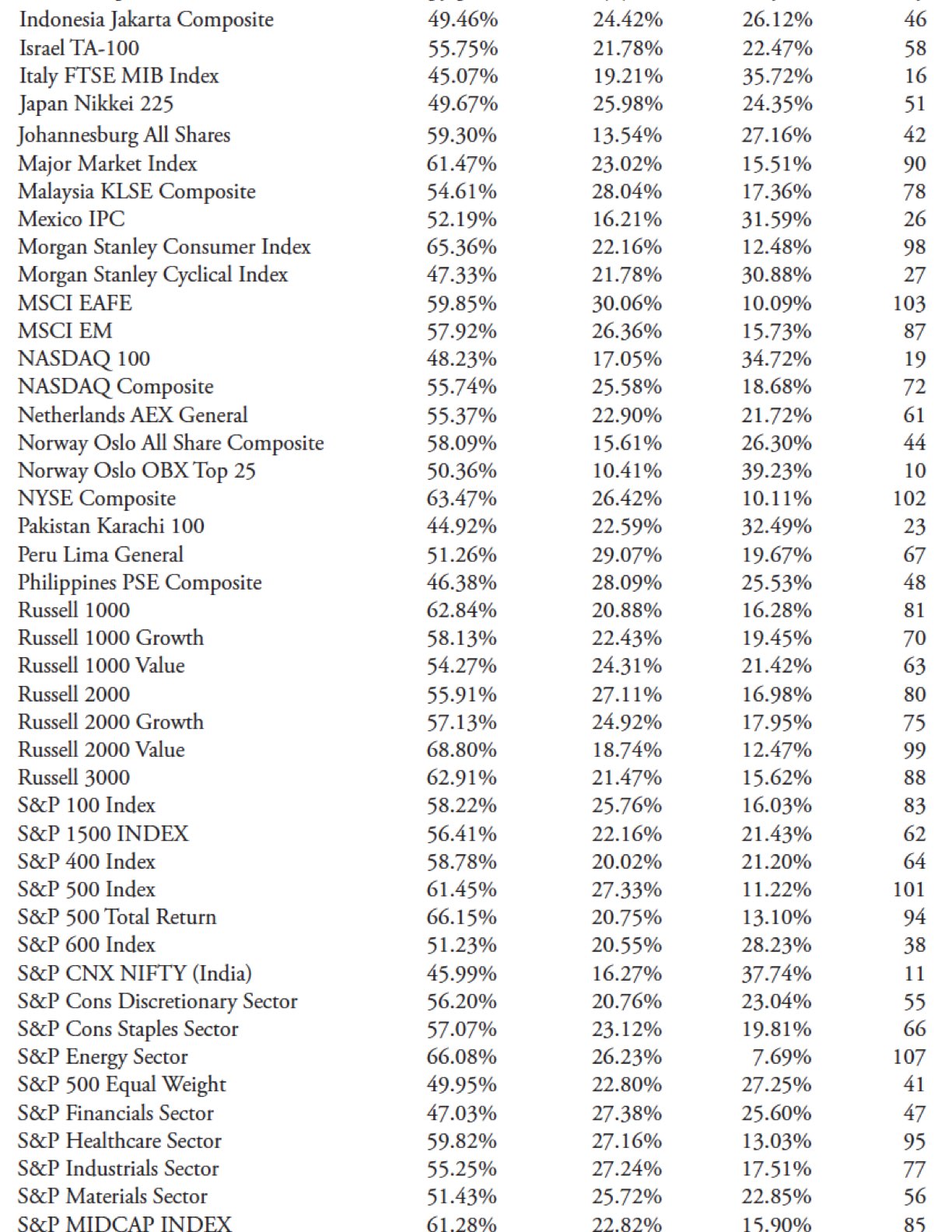
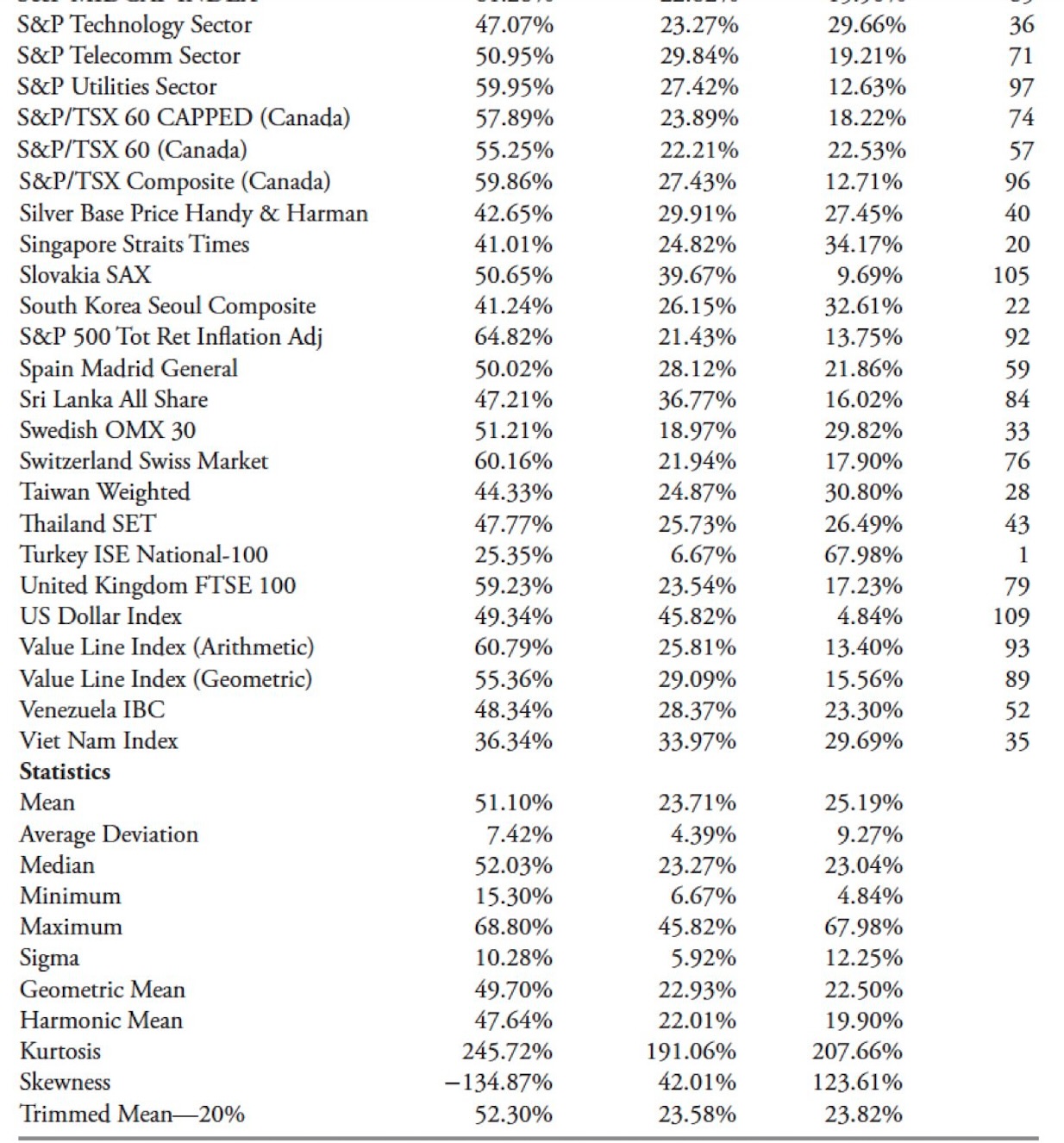
Comparability of Trendiness One Rank and Trendless Rank
Though I feel this was fairly apparent, Determine 10.7 exhibits the evaluation math is constant and acceptable. These two sequence ought to primarily be inversely correlated, and they’re with coefficient of dedication equal to 1.
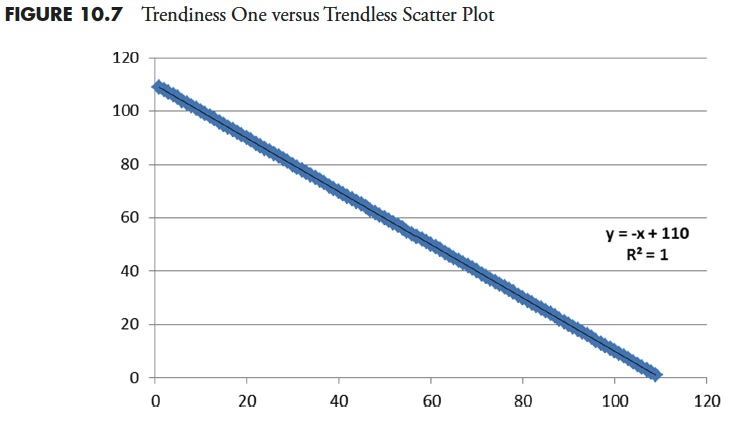
The next tables take the information from the complete 109 indices and subdivide it into sectors, worldwide, home, and time frames to make sure there’s robustness throughout a wide range of knowledge. There are lots of indices that seem in lots of, if not most of, these tables, however retaining knowledge of that kind for comparability with others that aren’t so broadly diversified will improve the analysis.
These tables present all three pattern methodology outcomes. This primary desk consists of all of the index knowledge. The remaining ones include subsets of the All desk, akin to Home, Worldwide, Commodities, Sectors, Knowledge > 2000, Knowledge > 1990, and Knowledge > 1980. The explanation for the information subsets is to make sure there’s a sturdy evaluation in place throughout varied lengths of information, which implies a number of bull-and-bear cyclical markets are thought-about along with secular markets. The Knowledge > 2000 signifies that the information begins someday previous to 2000 and subsequently completely comprises the secular bear market that started in 2000.
All Trendiness Evaluation
Desk 10.9 comprises knowledge from all the 109 indices within the evaluation. The primary column comprises letters figuring out the subcategory for every difficulty as follows:
I – Worldwide
S – Sector
C – Commodity
Clean – Home
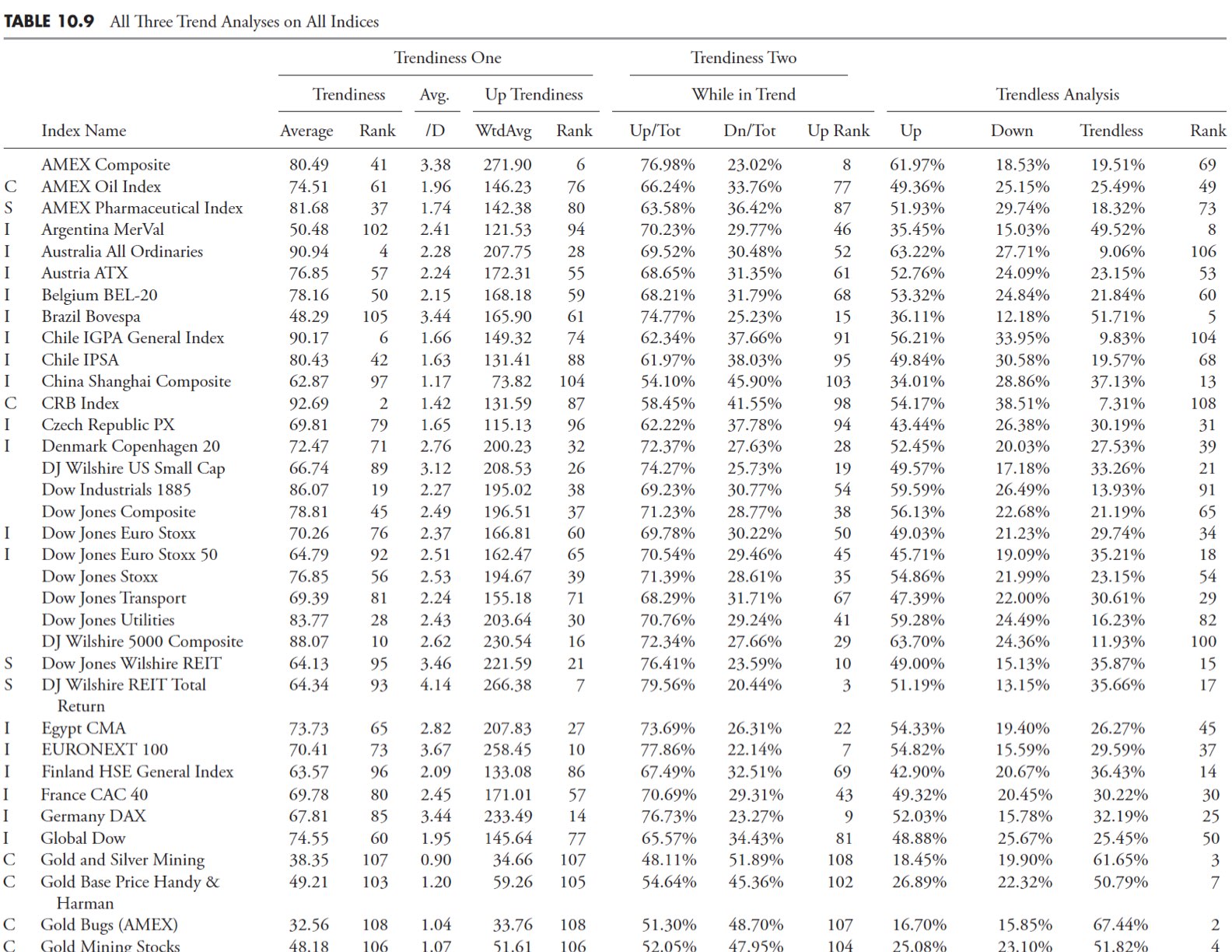



Pattern Desk Selective Evaluation
On this part, I’ll display extra particulars on chosen points from Desk 10.9 to indicate how the information may be utilized.
Utilizing the Trendiness One Rank, you possibly can see that the U.S. Greenback Index is primary. You can even see it’s the worst for being Trendless (final column), which one would count on. Nevertheless, in the event you have a look at the Trendiness One and Trendiness Two Up Ranks, you see that it didn’t rank effectively. This could solely be interpreted that the U.S. Greenback Index is an effective downtrending difficulty, however not a superb uptrending one primarily based on this relative evaluation with 109 varied indices. That is made clear from the lengthy trendline drawn from the primary knowledge level to the final knowledge level and is clearly in a downtrend.
Determine 10.8 exhibits the U.S. Greenback Index with a 5% filtered wave overlaid on it. The decrease plot exhibits the filtered wave of 5% measuring the variety of days throughout every up and down transfer. The 2 horizontal traces are at +21 and -21, which signifies that actions inside that band usually are not counted within the trendiness or trendless calculations. The one distinction between what this chart exhibits and what the desk knowledge measures is the truth that the desk is averaging quite a lot of completely different filtered waves and pattern lengths.
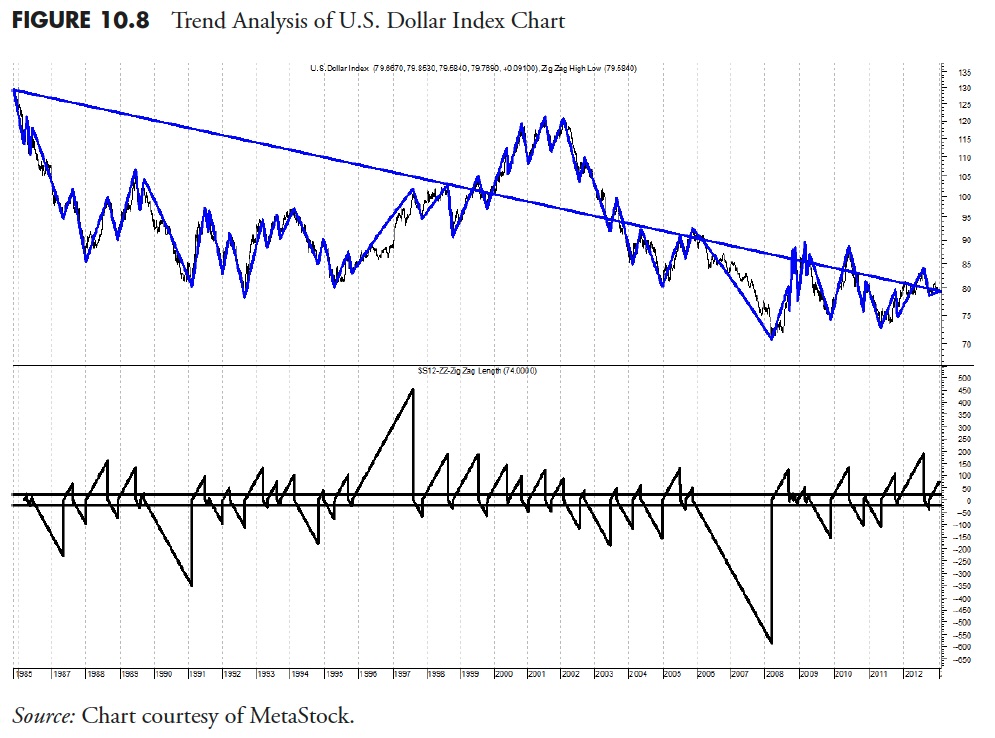

Let’s now have a look at the worst trendiness index and see what we will discover out about it (Desk 10.9). The Trendiness One rank and the Trendless Rank affirm that this isn’t a superb trending index. Moreover, the Up Trendiness in each One and Two additionally exhibits that it ranks low (109 and 81) within the Trendiness One, which is measuring the trendiness primarily based on all the information, and that the rank in Trendiness Two is excessive (4). Do not forget that Trendiness Two solely appears on the trending knowledge, not all the knowledge. Due to this fact, you possibly can say that this index when in a trending mode, tends to pattern up effectively, however the issue is that it’s not in a trending mode usually (see Desk 10.11).

Determine 10.9 exhibits the Turkey ISE Nationwide-100 index with the identical format as the sooner evaluation. Discover that it’s typically in an uptrend primarily based on the long-term pattern line. From the underside plot, you possibly can see that there’s little or no motion of developments exterior of the +21 and -21 day bands. Backside line is that this index would not pattern effectively, and is kind of unstable in its worth actions; if you’re pattern follower; do not waste your time with this one. A query which may come up is that it is usually clear from the highest plot that it’s in an uptrend, so in the event you used a bigger filtered wave and/or completely different pattern size, it’d yield completely different outcomes. My response to that’s merely: after all it should, you possibly can match the evaluation to get any outcomes you need, particularly with all this glorious hindsight. Dangerous method to profitable pattern following.
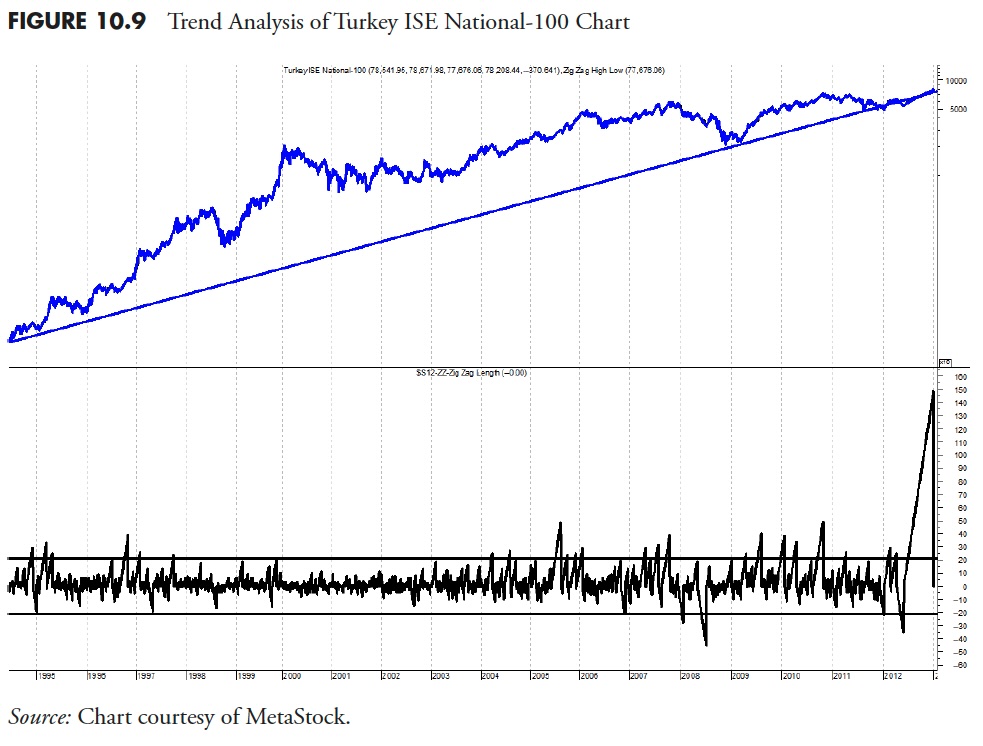
Utilizing the identical knowledge desk, let us take a look at an index that ranks excessive within the uptrend rankings (Desk 10.9). From the desk it ranks as center of the street comparatively primarily based on Trendiness One and Trendless rank. Nevertheless, the rank for Up Trendiness One and Trendiness Two Up rank is excessive (each are 5). Because of this many of the trendiness is to the upside with solely reasonable downtrends (see Desk 10.12).

Determine 10.10 exhibits the Norway Oslo Index clearly in an uptrend. The underside plot exhibits that many of the spikes of pattern size are above the +21 band degree and only a few are beneath the .21 band degree. This confirms the information within the desk.
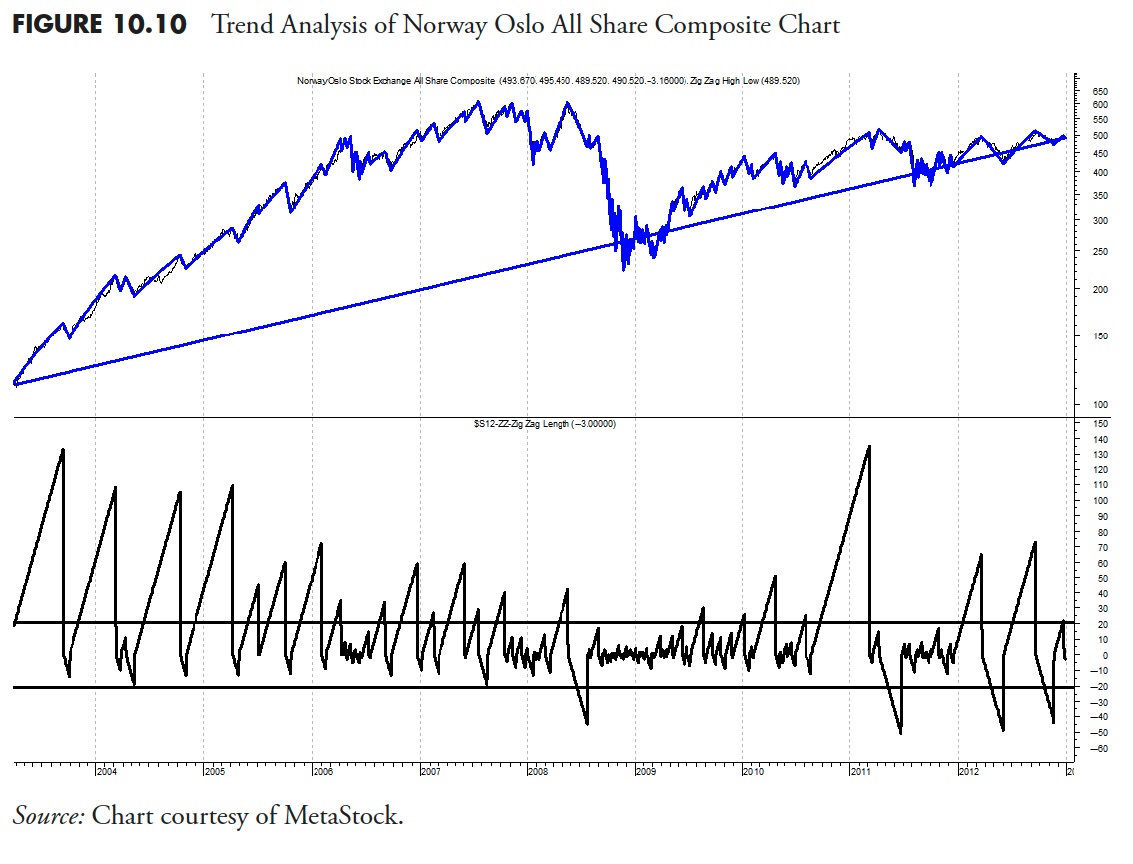
With a purpose to carry this evaluation to fruition, let us take a look at the index with the worst uptrend rank (Desk 10.9). From the desk, the Trendiness One and Two Up ranks are lifeless final (109). The Trendiness One total rank is 104, which is nearly final, and the trendless rank is 6, which confirms that knowledge (see Desk 10.13).

Determine 10.11 exhibits that the Hanoi SE Index is clearly in a downtrend; nevertheless, the underside plot exhibits that only a few developments are exterior the bands. And those that transfer effectively exterior the bands are the downtrends. As earlier than, one can change the evaluation and get desired outcomes, however that isn’t the way it needs to be completed. One observe, nevertheless, is that this index doesn’t have quite a lot of knowledge in comparison with many of the others and this needs to be a consideration within the total evaluation.
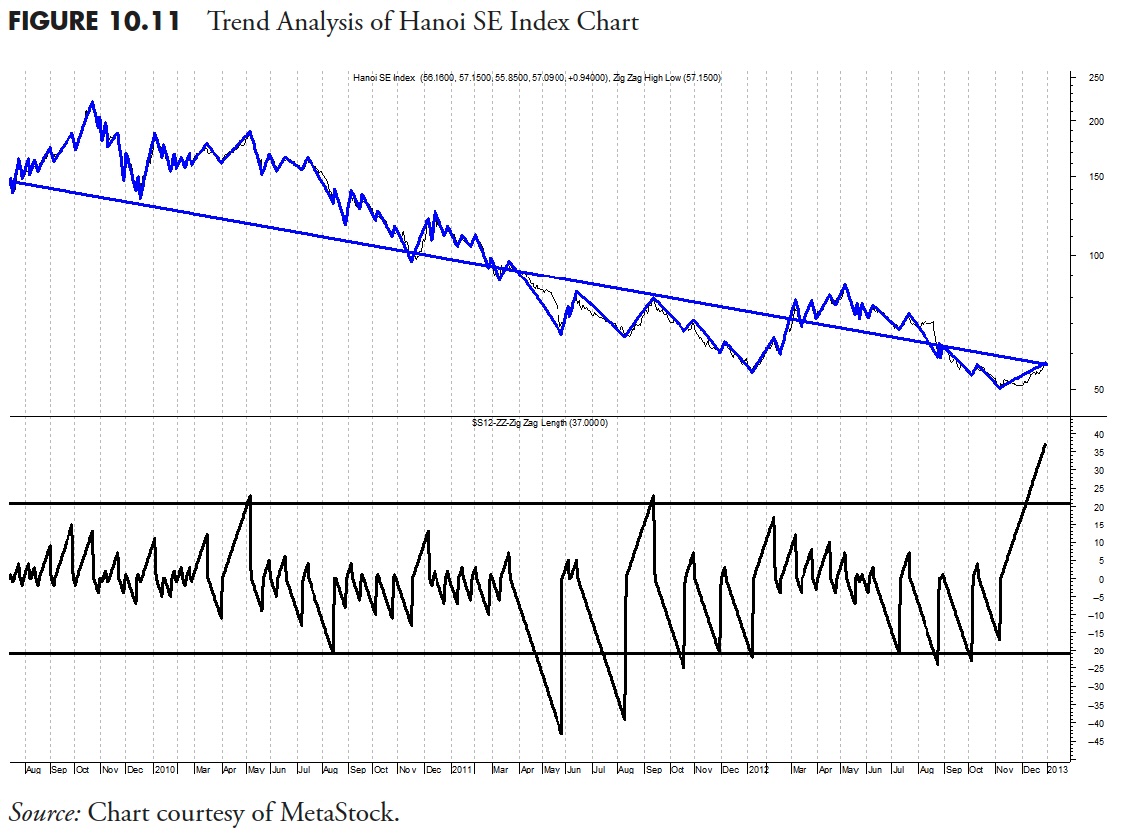
Thanks for studying this far. I intend to publish one article on this sequence each week. Cannot wait? The ebook is on the market right here.

